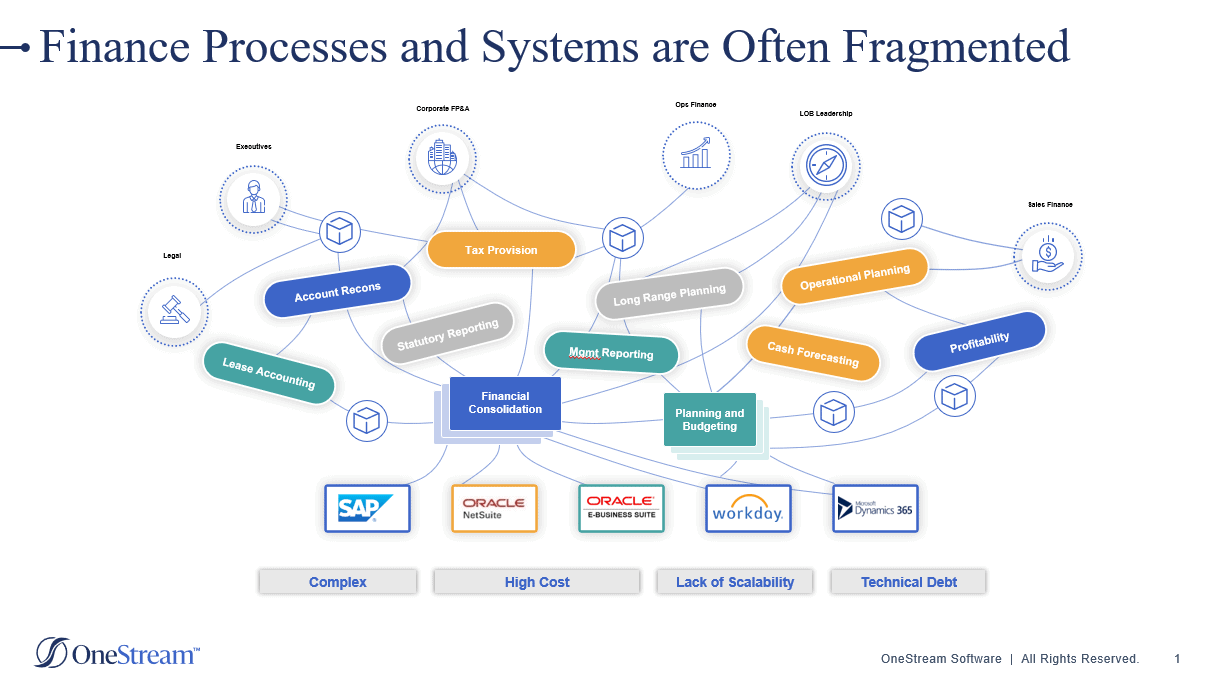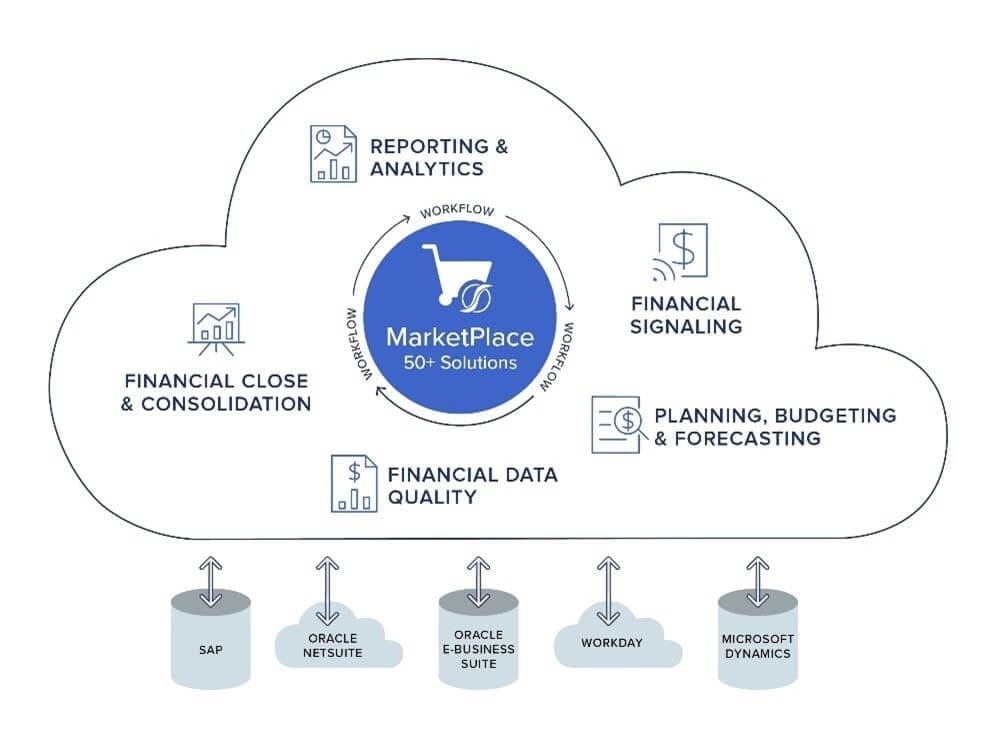In today’s competitive and volatile economic environment, it’s important for everyone in an organization to have visibility into corporate strategy and to make sure their personal and departmental goals and plans are aligned to corporate goals and objectives. This is easier said than done and requires a structured management process to be in place across the enterprise.
That’s the role of a corporate performance management (CPM) process and software platform. Read on to learn more about how CPM software helps organizations link their strategy to plans and execution.
Supporting a Continuous Management Cycle
Sometimes those who are new to the concept of corporate performance management (CPM) and CPM Software ask how it’s different from enterprise resource planning (ERP) processes and systems. They certainly sound similar on the surface.
The easy answer is that ERP systems help organizations “run” their business on a day-to-day basis. That means taking orders, manufacturing products, distributing them, billings and collections, purchases and payments, depreciating fixed assets, and general accounting.
As a complement to ERP systems, CPM processes and software help organizations “manage” the business. The primary role of CPM is to help organizations link their corporate strategy and goals to their plans and execution in a continuous management cycle. (see figure 1)
Figure 1: The Performance Management Cycle
Dissecting the 6 Steps in the CPM Cycle
Let’s look at the CPM processes in a bit more detail and highlight how they work together to create a continuous management cycle.
- Goal-Setting – this is the starting point. Corporate business strategies typically contain a set of high-level, strategic goals and objectives. These could be quantified in the form of targeted revenue or revenue growth, ROI (return on investment), market share, customer satisfaction and retention, carbon emissions, employee retention, staff diversity, workforce incidents, and many others.
- Modeling – scenario modeling is an important step in translating corporate goals and objectives to business models. It’s an essential tool for understanding key business drivers, such as what drives revenue growth. The answer could include orders, shipments, pricing, returns and allowances, new customer acquisition, customer retention, or other factors. By understanding and flexing key business drivers, management teams can create a 3 to 5-year strategic financial plan, with multiple scenarios, that can then be translated into annual budgets and operating plans.
- Planning – planning is a critical step for translating corporate business strategy to execution. Through the annual operating plan (AOP) or budgeting process, the enterprise’s short-term goals and targets are communicated throughout the organization to start the process. Then individual departments and functions develop their plans, including workforce/people plans, capital plans, and operating expense budgets that can then be aggregated and aligned to the corporate plan.
- Consolidation – while it would be nice to be able to close the books and review financial results on a daily basis, this isn’t feasible in most organizations, especially if they are relying on multiple ERP systems to run the business. So financial results need to be collected and consolidated on a periodic basis to create a snapshot of financial performance. This process is typically run monthly and includes currency translation, intercompany eliminations, allocations, accounting for partial ownerships, and reporting in accordance with accounting standards including US GAAP, IFRS, and others.
- Reporting – going hand in hand with consolidation is the reporting of financial and operating results to internal and external stakeholders. This comes in a variety of forms including financial statements and regulatory filings, board books, and management reporting.
- Analysis – the analysis of financial and operating results includes comparing actual results to the original budget or latest forecast and understanding the causes behind material variances. It also includes comparing current period results to prior periods and performing trend analysis, as well as comparing revenue and profits across product lines, divisions, customer segments, channels, and other aspects of the business.
The results of the analysis step in the CPM process will often impact key business decisions regarding hiring, spending, allocation of resources, investment, or divestments. As depicted in the closed-loop CPM cycle above, this means updating business models, updating plans and forecasts, and then continuing to monitor the results in the next cycle.
The key to success in CPM is integrating and aligning these steps so they work in a continuous cycle, linking corporate strategy to plans and execution, to create a competitive advantage. This frequency of execution can vary depending on the industry and nature of the organization. Most organizations run this cycle at least quarterly, while organizations in fast-paced industries may execute it on a monthly or weekly basis.
Pros & Cons of CPM Technology Approaches
Executing a closed-loop CPM cycle that links corporate strategy to plans and execution is nearly impossible without the use of technology. And there are several technology alternatives available to support CPM including spreadsheets, point applications, or unified CPM software solutions. Here’s a quick look at the pros and cons of each of these alternatives.
Spreadsheets and email – this can be an attractive approach given their low cost, wide availability, and familiarity to most Finance and business professionals. And the spreadsheet approach can be viable for very small enterprises. But as organizations grow and evolve in size and complexity the spreadsheet approach often breaks down – causing errors, constant reconciliation of data, and delayed planning and reporting processes.

Figure 2:Fragmented Point Solutions
Point Applications – there are many point applications available in the market designed to support specific corporate levels processes such as goal setting, planning, financial close management, consolidation, and reporting. And while these applications offer more functionality and control than spreadsheets, there are some downsides. For instance, organizations relying on multiple point solutions to support the complete CPM cycle will find their users spending a large amount of time moving or copying data from one application to another, reconciling differences, and having to deal with multiple points of maintenance. (see figure 2)
Unified CPM Software – this approach provides the functional advantages of purpose-built applications over spreadsheets, but in a single software platform that unifies the data and processes. With unified CPM software solutions, users spend less time moving and reconciling data and managing software applications and more time on value-added analysis of the business and supporting more effective strategic decision-making across the enterprise. (see figure 3)

Figure 3: OneStream Unified CPM Platform
Conclusion
Linking corporate strategy to plans and execution is essential for success in any enterprise – be it small, medium, or large. Corporate performance management (CPM) is a management process designed to link corporate strategy to plans and execution, in a continuous cycle consisting of six key steps. When supported by the appropriate CPM software technology, an effectively managed CPM cycle leads to improved communication, optimized resource allocations, agile strategic decision making, and better business outcomes.
To learn more download our white paper titled “Taking Performance Management to the Next Level with Intelligent Finance” and contact OneStream if your organization is ready to move beyond the limitations of spreadsheets and legacy CPM applications to unified CPM software platform.
Get Started With a Personal Demo



